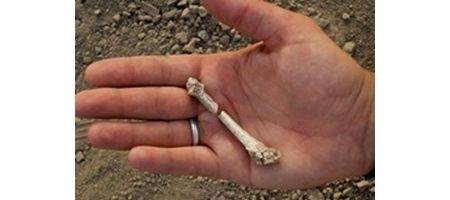A new type of hominid foot bone has been discovered in the Afar region of Ethiopia, showing that ‘Lucy’, the famous early human ancestor, had company.

The 3.4 million-year-old bones have been shown not to belong to Australopithecus afarensis, but instead to a creature that spent much of its time in trees. It hasn’t yet been assigned a species, as no skull or teeth have yet been found.
“The Burtele partial foot clearly shows that at 3.4 million years ago, Lucy’s species, which walked upright on two legs, was not the only hominin species living in this region of Ethiopia,” says Dr. Yohannes Haile-Selassie of the Cleveland Museum of Natural History.
“Her species co-existed with close relatives who were more adept at climbing trees, like ‘Ardi’s’ species, Ardipithecus ramidus, which lived 4.4 million years ago.”
The partial foot is the first evidence that at least two pre-human species with different modes of locomotion lived side by side in eastern Africa around 3.4 million years ago.
While the big toe of Australopithecus afarensis was aligned with the other four toes for human-like bipedal walking, the Burtele foot has an opposable big toe like the earlier Ardi.
“This discovery was quite shocking,” says Dr Bruce Latimer of Case Western Reserve University.
“These fossil elements represent bones we’ve never seen before. While the grasping big toe could move from side to side, there was no expansion on top of the joint that would allow for expanded range of movement required for pushing off the ground for upright walking. This individual would have likely had a somewhat awkward gait when on the ground.”
The fossils were found below a sandstone layer, and dated using the argon-argon radioactive method.
“Nearby fossils of fish, crocodiles and turtles, and physical and chemical characteristics of sediments show the environment was a mosaic of river and delta channels adjacent to an open woodland of trees and bushes,” says Dr Beverly Saylor of Case Western Reserve University.
“This fits with the fossil, which strongly indicates a hominin adapted to living in trees, at the same time ‘Lucy’ was living on land.”






